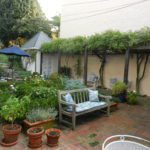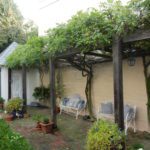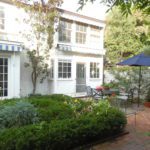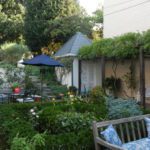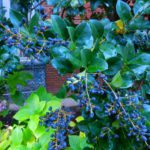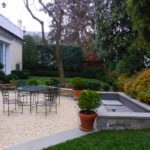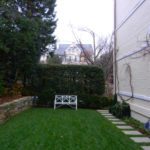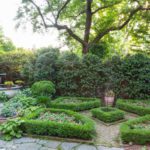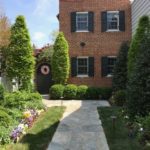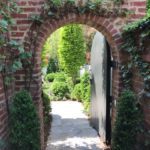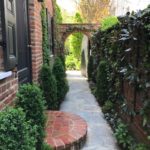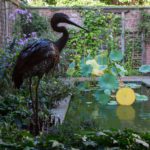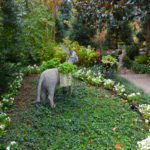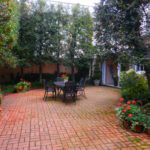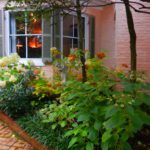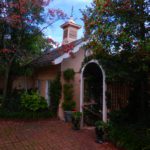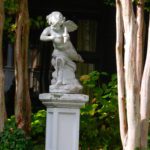Behind the Walls: The 89th Annual Georgetown Garden Tour
By • May 3, 2017 0 1070

Baby turtles, weddings, the Whiffenpoofs, a great blue heron, a cat burial ground (really). Life, death and rebirth in every corner of every garden are tucked behind the high brick walls in Georgetown.
In a neighborhood so famous, and so full of people, these pockets of green are Georgetown’s secret. “I always wanted a walled garden,” says Ellen Charles, whose lush backyard hides behind towering brick walls only a block from the chaos of Wisconsin Avenue.
Charles’s garden, along with seven others, will reveal its secrets Saturday, May 13, for the annual Georgetown Garden Tour, which is run by the Georgetown Garden Club and raises money for local projects.
All the gardens have pasts. Kitty Kelley’s elevated (in all senses of the word) garden is all about the circle of life, from book parties to weddings to the aforementioned cats. She lives in former Supreme Court Justice William Brennan’s old house. “So I feel the place showers me with a protective karma,” she says. And there are angels all around to prove it.
A spectacular O Street garden was recently listed in the Smithsonian Institution’s Archives of American Gardens. This garden has not one but two ponds: one formal, one à la nature. An artist’s studio stands next to the garden, hidden, or reflected, in a trompe-l’oeil latticed mirror.
Near Georgetown University, Jane Austen hangs out in a 35th Street gem of a garden.
“When the owner came to us, she said that she would love a garden in which she could read English novels,” explains Leslie Gignoux of Fritz & Gignoux, who designed the space. “In a tiny space, we carefully integrated elements drawn from Jane Austen’s novels to create an authentic cottage garden in which to read great novels under flowering canopies or — in the case of busy people — imagine that she could read her favorite books.”
All the gardens have pasts, all the gardens have secrets. And a lot of them have water. Swimming pools, fishponds and fountains grace most of the gardens. Many of them are on more than one level; steps lead to hidden “rooms” and swimming pools. One garden boasts a pea-gravel terrace, to remind one of a Parisian park.
Another garden takes Georgetown’s ubiquitous street trees, ginkgos, and presents them espaliered. Designed by the owners, this garden boasts a British-style conservatory and geothermal swimming pool. Cool.
Not last, our own Tudor Place is on show, the block-wide garden full of history and impressive in its sheer size. Built high to catch the summer breezes, Tudor Place dates from Georgetown’s early days as a busy port. The garden was first used as both a place of quiet and for small-scale farming. Successive generations were careful to preserve unusual heirloom plants and garden features (though no one farms there anymore).
As every gardener knows, the in-between spots make all the difference, and this is a special bonus of the Georgetown Garden Tour. There are plenty of things to see — lovely front gardens, subtle architectural details and historical secrets — all over our neighborhood. With property owners fussing and tweaking, it is fun just to walk around and stare.
Oh, and that great blue heron? It came to visit one quiet morning and ate all the fish in Ellen Charles’s fishpond.
The Georgetown Garden Club Story
Founded in 1924, the Georgetown Garden Club has been responsible for the Georgetown Garden Tour since 2000.
The tour was first organized in 1928 by Edmonia Whitehead as a way of involving the community in educating inner-city children. It benefited the Georgetown Children’s House, the first integrated childcare center in the city, providing greatly needed funds for the organization through the 1990s.
At that time, due to insufficient subsidies from the United Way and the District’s Department of Human Services, the Georgetown Children’s House closed. By then, many members of the Georgetown Garden Club had become involved in the annual tour, so it seemed only natural for the club to step in and take over the tour’s organization.
Now 51 members strong, the Georgetown Garden Club organizes this springtime tour, showcasing distinctive gardens on the east side and west side of Washington’s oldest neighborhood.
Since 2000, the club has raised more than a half million dollars. These proceeds benefit green spaces and parks throughout Georgetown and provide funds for inner-city youth to learn about gardening and conservation through the Student Conservation Association. Their work in Dumbarton Oaks Park has contributed to the revitalization of that park, in the process inspiring lifelong stewardship of the environment in the minds of many young workers.
Other beneficiaries include Book Hill Park, Montrose Park, Tudor Place, Volta Park, Rose Park, Trees for Georgetown, the Georgetown Library and the Georgetown Waterfront Park.
— Victoria Rixey

